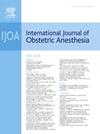Effect of metoclopramide on gastric volume and nausea and vomiting in fasted patients undergoing elective cesarean delivery: a randomized clinical equivalence trial
IF 2.3
3区 医学
Q2 ANESTHESIOLOGY
引用次数: 0
Abstract
Background
The American Society of Anesthesiologists Practice Guidelines for Obstetric Anesthesia recommend preoperative fasting and aspiration prophylaxis including non-particulate antacids, H2-receptor antagonists, and/or metoclopramide for elective cesarean deliveries. This study evaluated the effect of metoclopramide on gastric volume in appropriately fasted patients undergoing elective cesarean delivery.
Methods
We conducted a single-center, randomized, placebo-controlled equivalence trial of appropriately fasted patients presenting for elective cesarean delivery. Patients were randomized to receive intravenous metoclopramide 10 mg or saline. Gastric ultrasound was performed before and 30 minutes after study medication administration in the right lateral decubitus and the supine positions. Gastric volumes were estimated using the Roukhomovsky and Perlas methods. We hypothesized that metoclopramide would not significantly decrease gastric volume compared to saline within the equivalence limits of ± 17 mL.
Results
Seventy-two patients completed the study. Median gastric volume estimates were greater using the Roukhomovsky compared to the Perlas method (pre-treatment difference 13 mL, P < 0.001; post-treatment difference 11 mL, P < 0.001). No differences in the number of patients identified as at risk for aspiration (gastric volume > 1.5 mL/kg) were found between groups. The median pre- to post-treatment difference in gastric volume between saline and metoclopramide groups, calculated using the Perlas method, was −1 mL (95 % CI −5 to 2, P = 0.375) and 1 mL (95 % CI −4 to 5, P = 0.981) using the Roukhomovsky method. Equivalence was determined significant for both methods (P < 0.001).
Discussion
In appropriately fasted patients, metoclopramide and saline were equivalent in their effect on gastric volume within ± 17 mL, showing metoclopramide administration had minimal effect on gastric volume in this low-risk population.
甲氧氯普胺对选择性剖宫产禁食患者胃容量和恶心呕吐的影响:一项随机临床等效试验
背景:美国麻醉医师学会产科麻醉实践指南推荐术前禁食和误吸预防,包括非颗粒抗酸剂、h2受体拮抗剂和/或甲氧氯普胺用于选择性剖宫产。本研究评估甲氧氯普胺对择期剖宫产适当禁食患者胃容量的影响。方法:我们对选择剖宫产的适当禁食患者进行了一项单中心、随机、安慰剂对照的等效试验。患者随机接受静脉注射甲氧氯普胺10mg或生理盐水。在研究用药前和用药后30分钟分别取右侧侧卧位和仰卧位进行胃超声检查。使用Roukhomovsky和Perlas方法估计胃容量。我们假设在±17 ml的等效范围内,甲氧氯普胺与生理盐水相比不会显著减少胃容量。结果72例患者完成了研究。与Perlas方法相比,Roukhomovsky方法估计的中位胃容量更大(治疗前差异13 mL, P < 0.001;治疗后差异11 mL, P < 0.001)。在确定有误吸危险的患者人数(胃体积>; 1.5 mL/kg)方面,两组之间没有差异。使用Perlas方法计算,生理盐水组和甲氧氯普胺组治疗前后胃容积的中位数差异为- 1 mL (95% CI−5 ~ 2,P = 0.375),使用Roukhomovsky方法计算胃容积的中位数差异为1 mL (95% CI−4 ~ 5,P = 0.981)。两种方法的等效性均具有显著性(P < 0.001)。在适当禁食的患者中,胃复安和生理盐水对胃容量的影响在±17 mL范围内是相等的,这表明在这一低风险人群中,胃复安对胃容量的影响最小。
本文章由计算机程序翻译,如有差异,请以英文原文为准。
求助全文
约1分钟内获得全文
求助全文
来源期刊
CiteScore
4.70
自引率
7.10%
发文量
285
审稿时长
58 days
期刊介绍:
The International Journal of Obstetric Anesthesia is the only journal publishing original articles devoted exclusively to obstetric anesthesia and bringing together all three of its principal components; anesthesia care for operative delivery and the perioperative period, pain relief in labour and care of the critically ill obstetric patient.
• Original research (both clinical and laboratory), short reports and case reports will be considered.
• The journal also publishes invited review articles and debates on topical and controversial subjects in the area of obstetric anesthesia.
• Articles on related topics such as perinatal physiology and pharmacology and all subjects of importance to obstetric anaesthetists/anesthesiologists are also welcome.
The journal is peer-reviewed by international experts. Scholarship is stressed to include the focus on discovery, application of knowledge across fields, and informing the medical community. Through the peer-review process, we hope to attest to the quality of scholarships and guide the Journal to extend and transform knowledge in this important and expanding area.

 求助内容:
求助内容: 应助结果提醒方式:
应助结果提醒方式:


